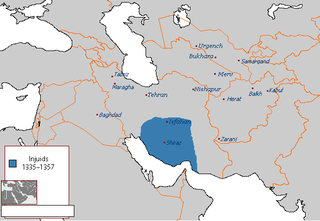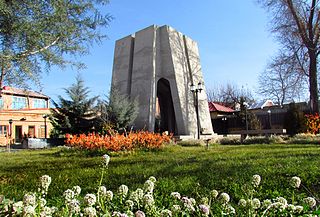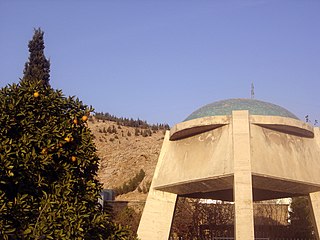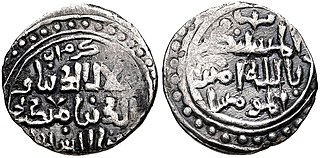
Isfahan is a city in Iran. It is located 406 kilometres south of Tehran, and is the capital of Isfahan Province.

Chishtī Muʿīn al-Dīn Ḥasan Sijzī, known more commonly as Muʿīn al-Dīn Chishtī or Moinuddin Chishti or Khwājā Ghareeb Nawaz, or reverently as a Shaykh Muʿīn al-Dīn or Muʿīn al-Dīn or Khwājā Muʿīn al-Dīn by Muslims of the Indian subcontinent, was a Persian Muslim preacher, ascetic, religious scholar, philosopher, and mystic from Sistan, who eventually ended up settling in the Indian subcontinent in the early 13th-century, where he promulgated the famous Chishtiyya order of Sunni mysticism. This particular tariqa (order) became the dominant Muslim spiritual group in medieval India and many of the most beloved and venerated Indian Sunni saints were Chishti in their affiliation, including Nizamuddin Awliya and Amir Khusrow. As such, Muʿīn al-Dīn Chishtī's legacy rests primarily on his having been "one of the most outstanding figures in the annals of Islamic mysticism." Although little is known of Muʿīn al-Dīn Chishtī's early life, it is probable that he travelled from Sistan to India to seek refuge from the increasing prevalence of Mongol military action in central Asia at that point in time. Having arrived in Delhi during the reign of the sultan Iltutmish, Muʿīn al-Dīn moved from Delhi to Ajmer shortly thereafter, at which point he became increasingly influenced by the writings of the famous Sunni Hanbali scholar and mystic ʿAbdallāh Anṣārī, whose famous work on the lives of the early Islamic saints, the Ṭabāqāt al-ṣūfiyya, may have played a role in shaping Muʿīn al-Dīn's worldview. It was during his time in Ajmer that Muʿīn al-Dīn acquired the reputation of being a charismatic and compassionate spiritual preacher and teacher; and biographical accounts of his life written after his death report that he received the gifts of many "spiritual marvels (karāmāt), such as miraculous travel, clairvoyance, and visions of angels" in these years of his life. Muʿīn al-Dīn seems to have been unanimously regarded as a great saint after his passing.

Kashan is a city in Isfahan province, Iran. At the 2017 census, its population was 396,987 in 90,828 families.

The Muzaffarid dynasty was a Persian dynasty of Arab origin which came to power in Iran following the breakup of the Ilkhanate in the 14th century. At their zenith, they ruled a kingdom comprising Iranian Azerbaijan, Central Persia, and Persian Iraq.

The House of Inju was a Shia dynasty of Mongol origin that came to rule over the Persian cities of Shiraz and Isfahan during the 14th century AD. Its members became de facto independent rulers following the breakup of the Ilkhanate until their defeat in 1357.

Awhaduddin Awhadi Maragheie (1271–1338) was a Persian poet from the city Maragha in Iran.

Hadi Sabzavari or Hajj Molla Hadi Sabzavari (1797–1873) was a famous Iranian philosopher, mystic theologian and poet.

Mass'oud Mirza Zell-e Soltan ("Mass'oud Mirza the Sultan's Shadow or Massud Mirza was a Persian prince of the Qajar Dynasty; he was known as the "Yamin-al-Dowleh". He was posted as the governor of Isfahan for over 35 years, and the governor of the Mazandaran, Fars, and Isfahan for a total of 40 years.

Allahverdi Khan was an Iranian general and statesman of Georgian origin who, initially a gholām, rose to high office in the Safavid state.
Mir Fendereski or Mir Findiriski (1562–1640) was a Persian philosopher, poet and mystic of the Safavid era. His full name is given as Sayyed Mir Abulqasim Astarabadi, and he is famously known as Fendereski. He lived for a while in Isfahan at the same time as Mir Damad spent a great part of his life in India among yogis and Zoroastrians, and learnt certain things from them. He was patronized by both the Safavid and Mughal courts. The famous Persian philosopher Mulla Sadra also studied under him.

Shah Shoja, was the ruler of the Muzaffarid dynasty from 1358 to 1384. He was the son and successor of Mubariz al-Din Muhammad. During the lengthy reign of Shah Shoja, his kingdom reached its zenith of power, stretching from Balochistan to Arran.

Bahāʾ al‐Dīn Muḥammad ibn Ḥusayn al‐ʿĀmilī was an Arab Shia Islamic scholar, philosopher, architect, mathematician, astronomer and poet who lived in the late 16th and early 17th centuries in Safavid Iran. He was born in Baalbek, Ottoman Syria but immigrated in his childhood to Safavid Iran with the rest of his family. He was one of the earliest astronomers in the Islamic world to suggest the possibility of the Earth's movement prior to the spread of the Copernican theory. He is considered one of the main co-founders of Isfahan School of Islamic Philosophy. In later years he became one of the teachers of Mulla Sadra.

Jalal ad-Din Mingburnu or Manguberdi, also known as Jalâl ad-Dîn Khwârazmshâh, was the last ruler of the Khwarezmian Empire.

Emamzadeh Ahmad(Persian: امامزاده احمد) is an imamzadeh in Isfahan, Iran. The emamzadeh comprises a tomb, to the north and west of which are two iwans; the tomb faces a vast yard where several famous people, like Amir Kabir's daughter and Naser al-Din Shah's sister and wife, are buried. The emamzadeh himself was likely the Sultan Ali's son, who has been buried in Mashhad-e Ardehal.

Baba Ghassem mausoleum is a historical mausoleum in Isfahan, Iran. It dates back to the 14th century. It is well known for its beautiful mihrab and dome. It is located to the north of Jameh Mosque of Isfahan. It was repaired and revamped in the Safavid era. Baba Ghassem was one of the prominent faqihs in Isfahan. One of his devotees built the Emamieh school for him, when Baba Ghassem was alive and after Baba Ghassem's death he built this mausoleum for him. The tomb has brick and tile decorations. Its dome is pyramidical. This mausoleum was very respected in the past, so that people swore to it beside the tomb for proving that they are telling the truth. On the below part of the dome of the structure, one of the names of Allah has been written in the Bannai script.

The Soltan Bakht Agha mausoleum(Persian: آرامگاه سلطان بخت آقا) is a historical mausoleum in Isfahan, Iran. Soltan Bakht Agha was Shah Sheykh Abu Esshaq's niece. Shah Sheykh Abu Esshaq was a handsome, good-natured but ill-fated King in the 14th century, who was contemporaneous with Hafez.

Takht-e Foulad(Persian: تخته فولاد) is a historical cemetery in Isfahan, Iran. The cemetery is at least 800 years old. In the 13th century in the Ilkhanid era Takht-e Foulad was the most important cemetery in Isfahan and all of the famous personalities have a mausoleum in this cemetery. Unfortunately all of the mausoleums from the Ilkhanid era, except Baba Rokn ed-Din mausoleum, which is the oldest structure in Takht-e Foulad, have been destroyed. In the Safavid era there were 400 mausoleums in Takht-e Foulad, but there are now only 8 mausoleums from the Safavid era. In the Qajar era a large part of the cemetery was destroyed, but the cemetery hasn't lost its importance and by the end of Pahlavi era it was the most important cemetery in Isfahan. There are 20 structures from the Qajar era and 17 structures from the Pahlavi era in the cemetery. Before the Safavid age the cemetery had been known as Lessan ol-Arz and Baba Rokn ed-Din, but from the Safavid age until now its name is Takht-e Foulad.

The Khaje Taj od-Din mausoleum is a historical structure in Kashan, Iran. In the 15th century, Khaje Taj od-Din, the brother of founder of Zeyn od-Din minaret, Khaje Zeyn od-Din, built a mosque with minarets and a school on the tombs of two Imamzadehs and some of his contemporary scientists and judges. In the course of time the mosque and minarets and school were destroyed and only two domes remained, which is named Khaje Taj od-Din mausoleum. The outer surface of its eastern dome has tile mosaic. Around the dome, it has been decorated with three rows of raised stucco inscriptions. The inscriptions are some poems in the Naskh and Thuluth scripts.
Nour ed-Din Mohammad Esfahani was a prominent Persian calligrapher. He lived in the 17th century. He was from Isfahan. He was Aboutorab Esfahani's son and Mohammad Saleh Esfahani's brother, who were both also famous calligraphers. He died in 1683.

Hassan Ali Nokhodaki Isfahani (Persian: حسنعلی نخودکی اصفهانی) jurist, philosopher, moralist and Shi'a. Hassan Ali Nokhodaki Isfahani, son of Rajab Ali Akbar Isfahani, was born into a very religious family.
















